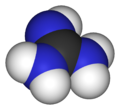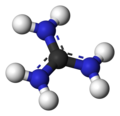Production
Guanidine can be obtained from natural sources, being first isolated in 1861 by Adolph Strecker via the oxidative degradation of an aromatic natural product, guanine, isolated from Peruvian guano. [8] [9]
A laboratory method of producing guanidine is gentle (180-190 °C) thermal decomposition of dry ammonium thiocyanate in anhydrous conditions:
- 3 NH4SCN → 2 CH5N3 + H2S + CS2
The commercial route involves a two step process starting with the reaction of dicyandiamide with ammonium salts. Via the intermediacy of biguanidine, this ammonolysis step affords salts of the guanidinium cation (see below). In the second step, the salt is treated with base, such as sodium methoxide. [8]
Isothiouronium salts (S-alkylated thioureas) react with amines to give guanidinium salts: [10]
- RNH2 + [CH3SC(NH2)2]+X− → [RN(H)C(NH2)2]+X− + CH3SH
The resulting guanidinium ions can often be deprotonated to give the guanidine. This approach is sometimes called the Rathke synthesis, in honor of its discoverer Bernhard Rathke. [11] [12]
Uses
Industry
The main salt of commercial interest is the nitrate [C(NH
2)3]NO
3. It is used as a propellant, for example in air bags.
Medicine
Since the Middle Ages in Europe, guanidine has been used to treat diabetes as the active antihyperglycemic ingredient in French lilac. Due to its long-term hepatotoxicity, further research for blood sugar control was suspended at first after the discovery of insulin. Later development of nontoxic, safe biguanides led to the long-used first-line diabetes control medicine metformin, introduced to Europe in the 1950s & United States in 1995 and now prescribed to over 17 million patients per year in the US. [14] [15]
Guanidinium chloride [14] is a now-controversial adjuvant in treatment of botulism. Recent studies have shown some significant subsets of patients who see no improvement after the administration of this drug. [16]
Biochemistry
Guanidine exists protonated, as guanidinium, in solution at physiological pH.
Guanidinium chloride (also known as guanidine hydrochloride) has chaotropic properties and is used to denature proteins. Guanidinium chloride is known to denature proteins with a linear relationship between concentration and free energy of unfolding. In aqueous solutions containing 6 M guanidinium chloride, almost all proteins lose their entire secondary structure and become randomly coiled peptide chains. Guanidinium thiocyanate is also used for its denaturing effect on various biological samples.
Recent studies suggest that guanidinium is produced by bacteria as a toxic byproduct. To alleviate the toxicity of guanidinium, bacteria have developed a class of transporters known as guanidinium exporters or Gdx proteins to expel the extra amounts of this ion to the outside of the cell. [17] Gdx proteins, are highly selective for guanidinium and mono-substituted guanidinyl compounds and share an overlapping set of non-canonical substrates with drug exporter EmrE. [18]
Other
Guanidinium hydroxide is the active ingredient in some non-lye hair relaxers.
This page is based on this
Wikipedia article Text is available under the
CC BY-SA 4.0 license; additional terms may apply.
Images, videos and audio are available under their respective licenses.






